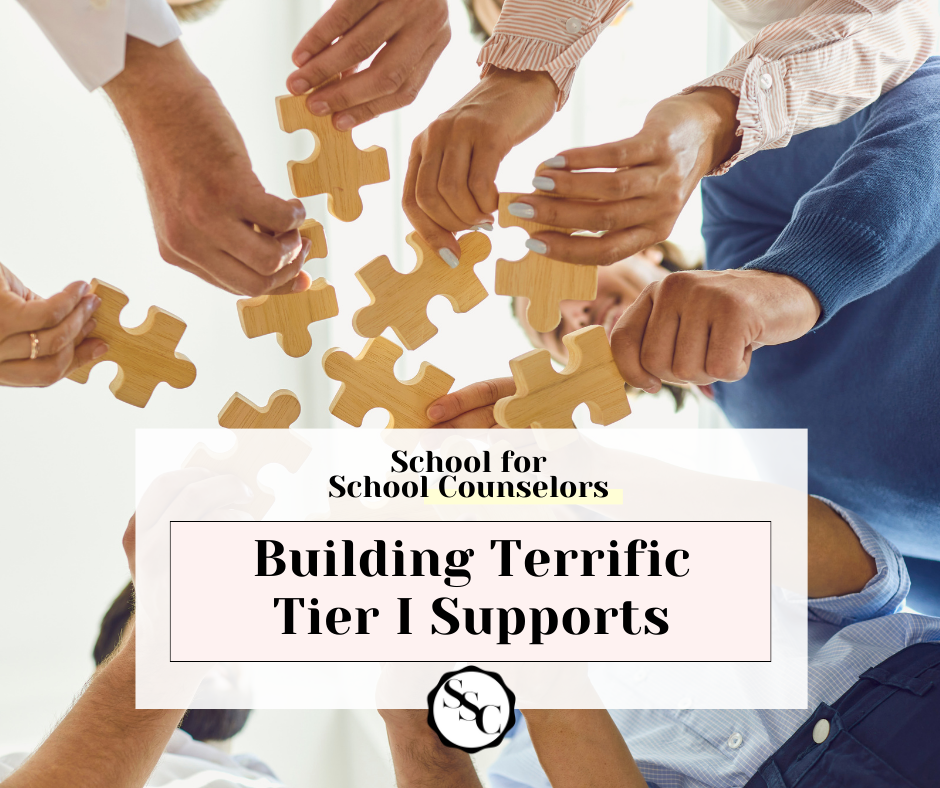Tune in as we get REAL about working in schools, serving students, and advocating for our roles. You've never heard school counseling like this.
School for School Counselors Podcast
We LOVE helping school counselors! From interviewing to learning about all the the
things they don't teach in grad school like 504, MTSS, and behavior intervention, we will help you become the most empowered & educated counselor-expert you can be!
SHARE:
Building Terrific Tier I Supports
Filed under:
We had the pleasure of talking with Jennifer M, a school counselor in California. Jennifer has worked in every grade level, ranging from elementary, middle, high school, and even K-8 schools. She has a vast amount of knowledge in the school counseling field, but also has first-hand teaching experience. Has this helped her become a better school counselor? Jennifer thinks so!
While not required in all areas of her county, Jennifer believes that being a teacher before being a counselor can provide information and experience to really help you in a school setting.
“[Having teaching experience] helps me have a better vision of what happens in the classroom.”
She has personal compassion for the teachers and “knows how they feel” in certain situations. Her teaching experience has also made her feel more comfortable in a classroom, driving her passion for classroom lessons and Tier 1 programming.
Tier 1 supports and large scale school programming is an important facet to comprehensive school counseling programs. “School counseling isn’t about the 1-to-1 and small groups. It’s about the large scale things, because then you see less 1-to-1 and less small groups.”
When you build a strong Tier 1 foundation for your school counseling program, everyone is getting services and everyone is building onto needed skills. A focus on preventative services decreases the demand for Tier 2 and 3 services.
How do you build a strong Tier 1 foundation? According to Jennifer, the first step is to look at your data. Look at your data.
Yes, you read that right. We wrote it twice because data-tracking is the MOST important thing you could possibly do! You should be building your programs and interventions around your school data; otherwise they may not be addressing or preventing the issues you need to address.
Look at your school’s state data and assessment scores:
What do the behavior referrals look like?
Where are the behavior gaps?
Is there a trending issue that your teachers have mentioned?
Is a certain grade level having more office referrals than others?
FINDING THE DATA WILL ALLOW YOU TO CREATE PROGRAMS THAT SUPPORT YOUR SCHOOL.
You should NOT create programs and THEN try to find the data to support why they are needed. Data FIRST. Programming SECOND.
In one of Jennifer’s schools, a resource teacher noticed that the students in her class were all struggling with anxiety and stress when it came to reading skills, which in turn made their reading issues worse. Jennifer then took a program she was already working on with therapy dogs for anxiety groups, and brought the dogs into the resource classroom to allow students to read to them. Tracking pre- and post- data on this intervention allowed her to see that the intervention was needed AND was effective.
Another example? The second grade team was sending more students to the office and writing more behavior referrals than most of the other classes. This pre-data allowed Jennifer to launch a “mindfulness boot camp” of classroom lessons for the second grade students. After teaching them mindfulness skills over the course of a few weeks, the office and behavior referrals for second grade began to decrease. This goes to show: the importance of data collection in your program can NOT be undervalued.
Another Tier I Implementation Step
The second step for a great Tier 1 program? Classroom lessons! After being a teacher, one of Jennifer’s strengths is classroom lessons and she sees the importance in it.
“When you put yourself out there in a classroom, students see you as approachable.”
You are able to get to know your students’ names and what they are like. Students begin to see you not only as a trusted adult, but as a relatable one: someone they don’t mind talking to.
Jennifer stated that the more she does classroom lessons, the fewer teacher referrals she gets. Students begin to feel more comfortable with seeking her out.
In addition to classroom lessons, be present at lunch times and transition times. Sponsor clubs, tutoring groups, or mentoring programs. See what your students need, and make it happen. When you are seen within the school and talk to your students, the buy-in for your program and your Tier 1 supports grows and the demand for Tier 2 supports decreases.
A Final Tier I Step
The final step for a great Tier 1 program and Jennifer’s self-proclaimed counseling superpower? Meet kids where they are at. Be present with your students and do it in the ways that meet their current needs. If you are required to do 504 meetings, find joy in it! Take advantage of the opportunity to provide support to a struggling student or to provide resources to a confused parent. Reframe your personal feelings for things you don’t like to do, and do whatever it takes. Whether it’s 504 or teaching or running a small group, you must address the actual needs of your students.
Jennifer has a wealth of knowledge and insight on classroom lessons, 504 coordination, and so much more! Hang out with Jennifer and all our school counseling colleagues in our Facebook group.
